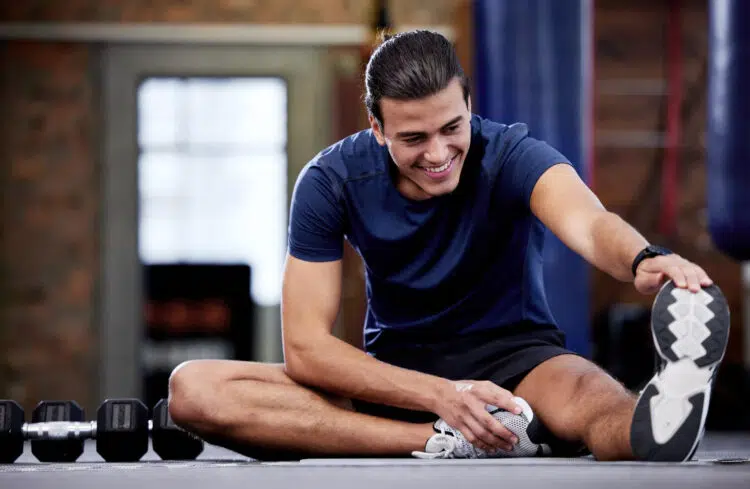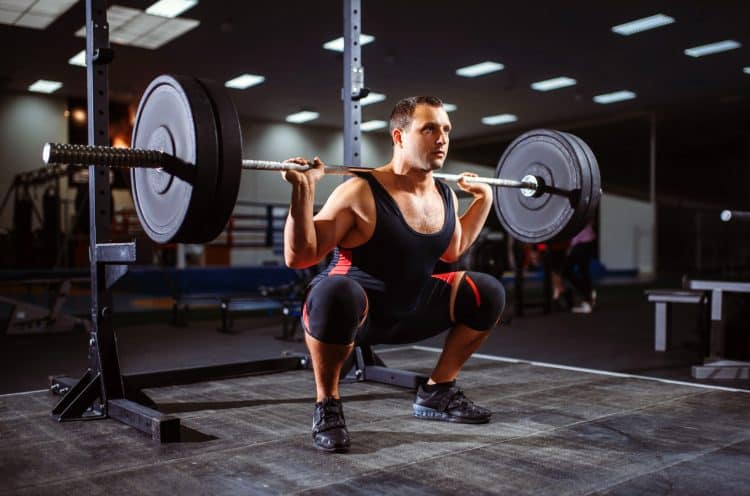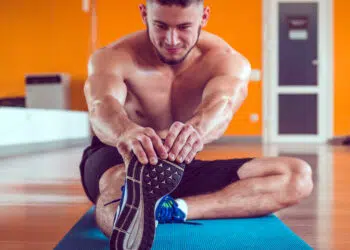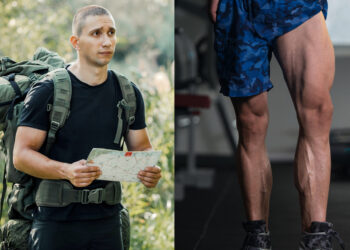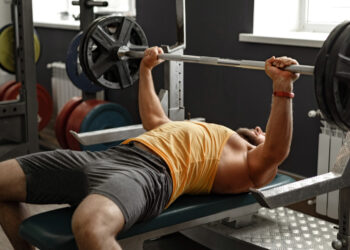The squat is the king of all exercises. It helps build leg strength, muscle mass, and overall functionality. That said, it is also one of the most challenging exercises, and most lifters hit a wall at some point that seems insurmountable.
My squat progress hit a run for a few reasons. Maintaining an upright torso became increasingly difficult, and achieving depth was uncomfortable. Plus, week after week, the weight felt heavier, my depth was shallowing, and a nagging hip pain was creeping in.
My 17 years as a personal trainer have taught me that consistent progress comes from addressing the root causes of performance plateaus, not just the surface-level symptoms.
Instead of trying to outdo my 315-pound squat PR by adding more volume and intensity, I decided to work on my mobility. The best part? I didn’t need to dedicate a whole workout to flexibility training. Instead, I just added a quick five-minute morning mobility flow to my routine for 30 days, and my squat PR shot up by a whopping 20 percent.
In this article, I reveal the impact of prioritizing mobility training on my squat performance and share insights into how to implement a similar mobility routine into your own routine.
Why Mobility Matters for Squats
Level Up Your Fitness: Join our 💪 strong community in Fitness Volt Newsletter. Get daily inspiration, expert-backed workouts, nutrition tips, the latest in strength sports, and the support you need to reach your goals. Subscribe for free!
Let’s be honest: Most strength trainers neglect mobility and usually do it on days when they have some extra time on hand (which isn’t often). However, poor mobility can spell doom for your overall strength and functionality. A systematic review published in the Journal of Sports Science found that mobility training can improve key sports performance variables. (1)
“There are two ways that lack of mobility can hinder hypertrophy and strength training. It can make it more challenging to get into the proper positions. Also, a lack of mobility can limit your ability to generate enough force throughout the entire range of motion of an exercise.” — Dr. Mike Israetel (Ph.D. in Sport Physiology)
Squat Anatomy
Here are all the muscles involved in a squat:
- Quads: These muscles at the front of your upper legs are the main drivers of the upward motion during a squat.
- Glutes: The biggest muscles in the body. They are involved throughout the squatting range of motion (ROM).
- Hamstrings: Located on the back of the femur, these help bend the knees and extend the hips.
- Hip Flexors: This group of muscles at the front of your hips helps lift your thighs.
- Adductors: These inner thigh muscles keep your knees tracking properly during the squat.
- Erectors: They run along your spine and keep your back straight during the squat.
- Ankles: One cannot overlook their role in maintaining balance and transferring force during the squat.
- Knees: A major joint that facilitates the squatting motion.
- Hips: The central hub of the squat.
If you haven’t noticed already, I’ve just listed the lower body muscles and joints. Stiffness in any of these areas can hinder your squat performance.
The 5-Minute Morning Mobility Routine
Many of my personal training clients ask me if they really need to work on their mobility if their primary objective is to get stronger. My answer is always a resounding yes.
Overall strength gains demand optimal functionality, which is only possible if you have decent mobility. Squatting with poor mobility will feel rusty and inefficient and can result in limited ROM, decreased power output, and compensatory patterns that can increase injury risk.
Without further ado, here are the five exercises that should be a part of your squat mobility routine:
Ankle Rockers
Stiff ankles can make it more challenging to keep your heels down during a squat. If you cannot squat with a proper form without a squat wedge or weightlifting shoes, I highly recommend you add ankle rockers to your routine.
How To Perform:
- Get into a half-kneeling position with your thighs at 90 degrees.
- Place your hands on the front knee.
- Extend your rear knee to flex your front ankle. Hinge at the hips and lean over to accentuate the ankle stretch.
- Your front knee should extend over your toes in the bottom position.
- Then, extend the front knee and pull the ball of your front foot off the floor as high toward the ceiling as possible while driving your hips backward.
- Return to the starting position.
- Repeat this for 30 seconds on each side.
Pro Tip: Instead of just flexing and pointing your toes, drive your heel away from you and then pull your toes back towards you. This exaggerated motion targets both the front and back of the ankle, enhancing overall mobility.
Hip Circles
Many lifters have trouble lowering their hips below the knee levels. This exercise can help unlock your ROM and allow you to get into the ‘hole.’
How To Perform:
- Stand with your feet shoulder-width apart, hands on your hips.
- Make large circles with your hips as if you are hula-hooping.
- Perform 30 seconds of clockwise circles.
- Keep your shoulders square and stable throughout the exercise.
- Then, switch to 30 seconds of counter-clockwise circles.
Pro Tip: Subtly tilt your pelvis forward and back during this exercise to engage the core muscles optimally and improve hip mobility.
Couch Stretch
I have a love-hate relationship with this stretch. But trust me, the couch stretch is a game-changer for tight quads and hips. It can improve your squat depth immensely.
How To Perform:
- Kneel down with your back toward a couch or a wall.
- Scoot back and place one foot flat on the floor and the other on the couch.
- The rear knee should be directly under the shoulders and hips.
- Keeping your back straight, squeeze the glutes and gently push the hips forward until you feel a deep stretch in the rear quad and glute.
- Place your hands on your hips or front knee for balance.
- Hold the stretch for 30 seconds on each side.
Pro Tip: People with good mobility should place the rear knee as close to the wall as possible, whereas others can position the knee farther from the wall.
Level Up Your Fitness: Join our 💪 strong community in Fitness Volt Newsletter. Get daily inspiration, expert-backed workouts, nutrition tips, the latest in strength sports, and the support you need to reach your goals. Subscribe for free!
Thoracic Spine Rotations
Torso mobility is as important for squat performance as lower body agility. A stiff back can make you lean forward during the movement, removing the tension from the quads and glutes and transferring it to the lower back. This stretch will help ensure you can maintain an upright torso throughout the ROM.
How To Perform:
- Get into a tabletop position on the floor.
- Place one hand behind your head and the other under the shoulder.
- Rotate your torso toward the side with your hand on the head. Go as far as your mobility allows and pause at full extension for five seconds.
- Repeat for a total of 30 seconds on each side.
Pro Tip: Keep your core braced throughout the exercise to focus on thoracic spine mobility and prevent lumbar spine engagement.
Cat-Cow
This is one of the most gentle stretches and activates the core by flexing and extending the spine. It also helps improve the stability of the squat by reinforcing your mechanics.
How To Perform:
- Assume a quadruped stance with your hands under your shoulders and knees under your hips.
- Initiate the movement by arching your back like a cat and tucking your chin into your chest. Focus on raising your spine as high toward the ceiling as possible.
- Then, slowly drop your belly toward the floor and look up toward the ceiling, creating a cow-like pose.
- Switch between the two poses for 30 seconds.
Pro Tip: Focus on your breathing during this exercise. Breathe in as you transition into a cow pose, and exhale as you get into the cat pose.
5-Minute Morning Mobility Flow
Here is the five-minute routine in a digestible form:
| Exercise Name | Work Time | Rest Time |
| Ankle Rockers (Each Side) | 30 Seconds | 10 Seconds |
| Hip Circles (Each Direction) | 30 Seconds | 10 Seconds |
| Couch Stretch (Each Side) | 30 Seconds | 10 Seconds |
| Thoracic Spine Rotations (Each Side) | 30 Seconds | 10 Seconds |
| Cat-Cow | 30 Seconds | – |
30-Day Implementation of the 5-Minute Morning Mobility Routine
I was following a PPL (push-pull-legs) routine during this 30-day challenge, meaning I trained my legs twice weekly, squatting on both days. Increasing your training volume progressively is a potent way of breaking through training plateaus.
Here is a week-by-week summary of the four-week mobility challenge:
Week One
My barbell back squat one-rep max had stagnated at 315 pounds, and I struggled to achieve depth in exercises like the leg press and hack squat. The first week of mobility training felt uncomfortable, to say the least. However, I noticed less creaking in my joints during lower body exercises.
Week Two
In the second week, the mobility routine started feeling less like a chore and more like a ritual. I was slowly but surely experiencing an improvement in my squat depth. On top of that, I added five pounds to the bar toward the end of the week.
On the third day of the week, I felt extra stiff, so I did an additional five minutes of the same mobility drill.
Week Three
I kicked off Week Three by hitting a 345-pound squat PR. That was not all; my recovery time between sets was noticeably shorter. This 35-pound jump reinforced that I was on the right path. I concluded the week with a 360-pound PR!
I also did this five-minute mobility drill before bed on days when I felt excessively sore, as it helps flush out metabolites from the muscle tissues and promote recovery. In the second mobility flow, you can also focus on stretches that target tight areas. For me, these were the hips, quads, and ankles.
Week Four and Beyond
Honestly, I was very nervous for the first session of the week and could only manage a 360-pound lift. Lifting heavy is as much a psychological challenge as it is physical. I tacked the next workout with a renewed mental outlook and crushed the 375-pound squat, achieving a new PR.
This 60-pound (20 percent) strength gain is proof that working on the underlying issue is vital to breaking through plateaus. I have no doubts in my mind that I would not have been able to achieve this without those five minutes of daily mobility training.
Like any other fitness regime, consistency is key here. You must learn to listen to your body. If you feel a sharp pain during any of the exercises, stop immediately and consult your healthcare provider.
Conclusion
I have undertaken several 30 to 60-day fitness challenges in my career, and I usually drop the routine after the stipulated time. However, the effectiveness and convenience of this five-minute mobility routine hit the sweet spot, and I will stick to it for the foreseeable future.
Mobility training can be an incredibly effective approach to combating strength and hypertrophy plateaus, and I encourage you to implement it into your training regimen.
That said, if you need help designing a mobility routine for your unique goals, drop your questions in the comments below, and I’ll be happy to help!
References:
- Skopal, L. K., Drinkwater, E. J., & Behm, D. G. (2024). Application of mobility training methods in sporting populations: A systematic review of performance adaptations. Journal of sports sciences, 42(1), 46–60. https://doi.org/10.1080/02640414.2024.2321006

